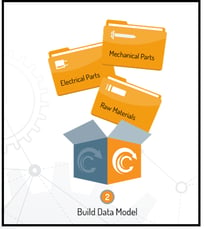Design Costs Link to Classification
1. Classification: - a simple concept saves money and time
Companies can leverage classification to reduce design costs. The scientific community regularly uses classification to understand relations among items, with the  plant and animal classification schemes perhaps the most familiar.
plant and animal classification schemes perhaps the most familiar.
A classification scheme groups relevant components in a logical and systematic hierarchy and brings technically similar items together, yet uses attributes to distinguish them by their specific details. A classification scheme embraces all existing items and is able to accept new items into the component population using attributes to create mutually exclusive locations for similar components and excluding dissimilar components.
An effective part classification scheme organizes components and allows for the quick and efficient location of parts, reducing search times and improving part reuse.
So how does classification affect design costs, consider the following:
2. Scenario – Part numbers are free, right?
An engineer is up against a deadline to complete a design. The design is nearly done, it simply requires a purchased component, maybe a fastener or an electrical part. The engineer searches various locations, like PDM, local hard drives, and other existing designs, but is unable to find the necessary part. Exasperated, the engineer creates a new part.
This scenario is all too familiar. A company’s component data is often dispersed across multiple locations with no effective search solutions to locate existing parts. It is often too difficult to know if the appropriate component exists and if it does exist where it exists. Eventually, the engineer begins to skip searching for parts and simply defaults to creating a new parts. For the engineer, at the front end of the design, the cost of creating a new part seems inconsequential, after all, part numbers are free, right?
3. Cost Implications
To the engineer with a deadline, the price of new part seems trivial, however, new parts have many costs implications. In fact, the US Defense Logistics Agency produced the Parts Management Guide and estimated the costs of introducing a new part to be $27,500, see Table 1.
Table 1: Average Cost of Adding a Part into a System
| ACTIVITY | COST ($) |
| Engineering and Design | 12,600 |
| Testing | 1,000 |
| Manufacturing | 2,400 |
| Purchasing | 5,200 |
| Inventory | 1,200 |
| Logistics Support | 5,100 |
| Total | 27,500 |
|
SD-19 Parts Management Guide, Defense Standardization Program |
|
The first cost encountered is the engineer’s time spent trying to find the appropriate part. Time is money and engineers sometimes spend up to 30% of their time searching for parts and, as described above, are often unable to find an appropriate part.
When an engineer gives up the search and creates a new part, a variety of costs are introduced, which cascade throughout a products lifecycle. A sampling of roles and lifecycle steps affected by new parts are listed in the table below.
Table 2: A sampling of roles and lifecycles steps.
| Lifecycle Step | Roles | Data and Documents |
| Concept Research | Design Engineers | Layouts & Schemes |
| Physical Design | Detail Designers | 3D CAD, FE, FEA, & 2D Data |
| Prototype Build | Development Engineers | Test Reports / test data |
| Part Sign-off | Various | Release Documents |
| Process & Routing | Manufacturing Engineers | Process Sheets |
| Tooling Design | Tool Designers | Tool & Gauge Drawings |
| Make Tools & Jigs | Tool Makers | Tool Stores records |
| Work Study | Industrial Engineers | Time Standards |
| Production Control | Production Controllers | Stores Space Allocation |
| Cost Accounting | Accountants | Materials & Prod Cost Data |
| Data Processing | Data Entry Clerks | Various Computer Records |
|
William F. Hyde, “Improving Productivity by CLASSIFICATION, CODING, |
||
Initially there are the costs to create or update a drawing and if needed model the component in CAD. A new part increases complexity in the design and presents unknown elements into the design, such as uncertain quality, requiring additional testing and can potentially increase maintenance and warranty costs.
A new part might have limited availability or long lead times creating costs through delays in manufacture or field repair. It might require approving a new vendor which not only requires additional time, potentially delaying a product launch, but also might require substantial administrative costs to approve the vendor.
Creating a new part which is a duplicate or a near duplicate of an existing part reduces the purchase lot sizes of the part, limiting leverage with the vendor and missing opportunities for volume discounts.
Duplicate and near duplicate parts require more components to be stored in inventory, increasing inventory costs through longer retrieval times, increased material, and augmented storage space.
In addition to the potential manufacturing delays, new parts add to the manufacturing costs by potentially increasing the number of components on a bill of materials, requiring new tooling and additional setup and/or changeover time to assemble components.
4. Classification can Help
A Classification system can avoid all of the above listed pitfalls by allowing fast and effective searches, streamlining the design process and improving part reuse.
An effectively designed classification scheme with quality data and managed with an effective classification tool allows for fast efficient searches enabling engineers to quickly find the appropriate components and eliminate the unanticipated, yet monumental, costs of creating a new part.



